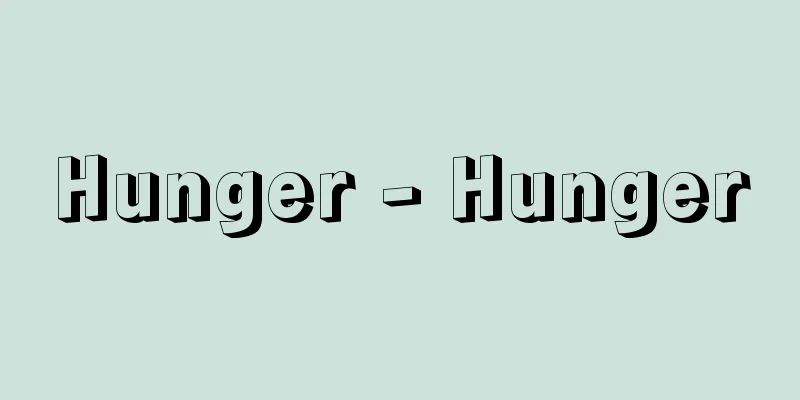Hunger - Hunger

|
Starvation is a state in which the supply of calories necessary to sustain life is insufficient. When the body is unable to supply sufficient calories due to inadequate food intake, it compensates by breaking down the elements that make up the body, mainly lipids. Starvation can also be called a state of malnutrition, but even if the necessary calories are supplied, there may be a lack of certain substances such as essential amino acids and vitamins, which is called malnutrition. Adults require 1,500 to 1,800 kilocalories per day as basic energy, about twice as much during exercise or in cold weather, and about three times as much during vigorous exercise. The most important cause of malnutrition is a lack of protein. Protein is not only an element that constitutes the body, but also forms enzymes necessary for metabolic regulation, so if more than one-third of the protein in the body is consumed, it is said that life cannot be sustained. Vitamin deficiency can cause various diseases, and some diseases increase the need for certain vitamins. Deficiency of inorganic substances is also seen in various diseases. When starvation continues for a long period of time, it leads to a deficiency of calories, protein, vitamins, and minerals, making it impossible to maintain metabolic regulation, resulting in a state of malnutrition with a variety of symptoms. Pathologically, edema caused by a lack of albumin (a type of protein) due to chronic nutritional deficiency is called starvation edema, which is thought to occur when the osmotic pressure of the plasma colloid decreases due to a decrease in albumin. This condition was commonly seen as a symptom of malnutrition in Japan immediately after the war. Starvation also causes atrophy of tissues and organs throughout the body, particularly in fat tissue and muscles, and atrophy of the spleen is particularly noticeable in organs, and deposition of hemosiderin is also observed. [Yutaka Watanabe] Source: Shogakukan Encyclopedia Nipponica About Encyclopedia Nipponica Information | Legend |
|
生体の生命維持のために必要なカロリーの供給不足状態を飢餓という。食物摂取不足などによって、本来必要とされるカロリーを十分に供給することができなくなると、生体は自己を構成する要素を、おもに脂質を分解させて補うことになる。飢餓は低栄養状態とも称することができるが、かりに必要なカロリーは供給されていても、必須(ひっす)アミノ酸やビタミンなどの特定の物質が欠乏している場合があり、これは別に栄養失調とよばれる。成人は基礎エネルギーとして1日1500~1800キロカロリーを必要とし、運動時あるいは寒冷下では約2倍、激しい運動時には約3倍のカロリーを要する。低栄養状態の原因としてもっとも重要なのはタンパク質の不足である。タンパク質は生体を構成する要素であるばかりでなく、代謝調節に必要な酵素も形成しているので、生体内のタンパク質の3分の1以上が消費されると、生命の維持は不可能とされている。ビタミンが欠乏すれば種々の疾病を生じるが、疾病によっては、あるビタミンの必要量をさらに増すことになるものもある。無機物質の欠乏も種々の疾病の場合にみられる。飢餓が長期間に及ぶと、カロリー、タンパク質、ビタミン、無機質の不足をきたし、代謝調節を維持することができなくなり、種々な症状が合併した低栄養状態となる。病理学的には、慢性の栄養不足によるアルブミン(タンパク質の一種)の欠乏によって生ずる浮腫(ふしゅ)を飢餓浮腫とよんでいるが、これは、アルブミン減少のために、血漿(けっしょう)の膠質(こうしつ)浸透圧が低下してできるものと考えられている。この病状は、敗戦直後の日本で、栄養失調症の症状として多くみられたものである。また、飢餓のために全身の組織、臓器の萎縮(いしゅく)がおこるが、脂肪組織、筋に著明で、臓器では脾臓(ひぞう)の萎縮が目だち、さらに血鉄素(ヘモジデリン)の沈着が認められる。 [渡辺 裕] 出典 小学館 日本大百科全書(ニッポニカ)日本大百科全書(ニッポニカ)について 情報 | 凡例 |
Recommend
Pretrial detention - Miketsu Koryu
The same as detention. Since detention is given to...
Amoco-Cazis Incident
...As a public institution, the Japan Coast Guard...
Shin-Yakushiji Temple
A Kegon sect temple in Takabatake-cho, Nara City....
Ulrich, A.
…On the other hand, the novels that increased in ...
Arrest on a different charge - Bekken Taiho
Investigative method in which a person is arreste...
Sports for the Disabled - Sports for the Disabled
Sports for people with physical and mental disabil...
Junichi Asano
1899-1981 A theologian and pastor from the Showa ...
Matsuzo Kakiuchi - Matsuzo Kakiuchi
A scholar of Japanese literature and Japanese lan...
Achin tribe
...They are an ethnic group belonging to the New ...
Nguyen Phuoc Anh - Nguyen Phuoc Anh
…The first emperor of the Nguyen Dynasty in Vietn...
Illustrated biography of Shinran Shonin
This is an illustrated scroll depicting the life o...
Silver mineral
A general term for minerals that contain silver. T...
Ajar people - Ajarjin
...Except for the coastal plains facing the Black...
Ayauta [town] - Ayauta
A former town in Ayauta County, central Kagawa Pre...
Indonesian Islamic Grand Conference - Indonesian Islamic Grand Conference
The Majlis Islamil A'laa Indonesia (Indonesia...









